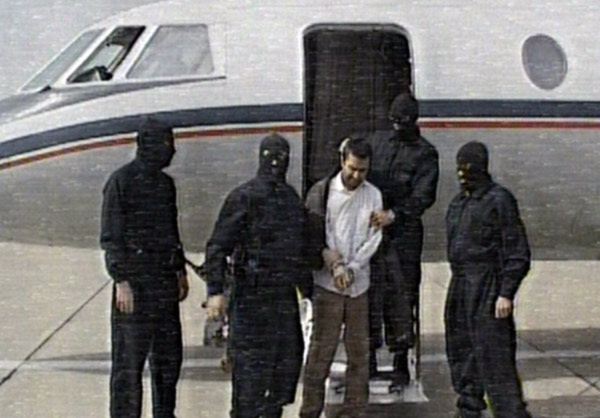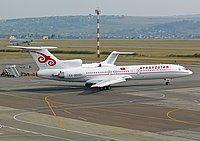
Iran carried out "two-plane" Rigi mission to embarrass Obama's Special Envoy
The government and intelligence services of Iran apparently have quite a sense of humor. Iran has managed not only to nab a top CIA-backed Baluchi terrorist but it also was able to keep the U.S. special envoy for Afghanistan and Pakistan waiting for Abdolmalek Rigi in Bishkek. The Iranians, in a clever move, captured Rigi from the Pakistanis aboard a Pakistan to Dubai small commuter jet aircraft, while the world believed Rigi was taken off a Kyrgyzstan airline flight from Dubai to Bishkek that was forced to land by Iranian Air Force jets at Bandar Abbas in Iran.
With the entire highly-vaunted U.S. intelligence community at his disposal, Holbrooke and his State Department and CIA team were forced to resort to dealing with Bishkek-Manas airport officials when their Iranian-Baluchi Jundallah guerrillas leader failed to show up in Bishkek on the Kyrgyzstan aircraft from Dubai.
On February 24, 2010, WMR reported, "Our sources state that Iranian intelligence is claiming very loudly that they captured Rigi without any foreign assistance. This appears to be for cover story purposes. If ISI delivered him to Bandar Abbas aboard a Lear [or Falcon], the Iranians had at least a half day to arrange for the touchdown of the KYRGYZSTAN Dubai-Manas flight to cover up the actual flight from Gwadar. If the Iranians had a couple of their agents pretend to be Rigi they fooled the world and allowed Pakistan's ISI to get off the hook as far as their involvement was concerned. Rigi was reported not to be traveling with bodyguards from Dubai to Bishkek, which does not explain the detention of another individual, reported by some sources to have been Jundallah's 'number two man.'"
According to Iranian state TV, Rigi drove in his Toyota from his house on Sariab Street in Kuwaiteh in Pakistan on February 21, leaving at 0955 local time and arriving in Chaman on the Pakistan-Afghanistan border at 1300 the same day. After crossing the border and arriving in Spin Boldak, Rigi was met by a local contact team and taken to Kandahar airbase where final arrangements were made for him to fly to Bishkek to meet with Holbrooke. At some point in time, possibly before February 21, Rigi was given a fake Afghanistan passport under the name "Mohammad Khalib." Rigi was also given a fake Pakistani travel document.
But it is at this point in time where the Iranian cover story begins. Iranian TV reported that on February 22, Rigi flew from Kandahar to Kabul for a brief layover before boarding Ariana Airlines flight 401 to Dubai. The Iranians report that Rigi arrived in Dubai at 2000 local time. Rigi reportedly spent a short time in Dubai before boarding Kyrgyzstan 454 to Bishkek. The Iranians claim that the Kyrgyzstan flight, once entering Iranian airspace, was forced to land in Bandar Abbas, where Rigi was taken into custody.
In an interview on Iranian TV, Rigi says he was flying to Bishkek to meet an "important" American. The reason for the clandestine meeting in Manas was that the American would be easily spotted if he met Rigi anywhere else.
At the time of the planned meeting between Rigi and the "important" American, AF-PAK Special Envoy Holbrooke was on a meandering journey in central Asia and Afghanistan "without a fixed schedule." Holbrooke was in Dushanbe, Tajikistan on February 19.
Holbrooke landed in Manas on February 19 and spoke to U.S. troops at the Manas Transit Center. Holbrooke then left for Afghanistan but arrived back in Manas on February 21, the day before the planned meeting with Rigi. The official story of Holbrooke's return to Kyrgyzstan was for an official meeting with Kyrgyzstan President Kurmanbek Bakiyev.
Iran conducted the charade with the Kyrgyzstan airline in order to keep Holbrooke waiting nervously at Manas. Iran had already captured their prize of Rigi when the ISI, possibly after Rigi's departure from Kuwaiteh or after he crossed into Afghanistan, took him under their protection and put him on the charter jet flight to Bandar Abbas. Possibly, ISI was at Spin Boldak and Rigi mistakenly believed the watch team was working for the CIA, when, in fact, they were working for the ISI, which had promised to turn Rigi over to the Iranians.
WMR's Asia-based intelligence sources believe that the Iranians discovered the plans for Rigi's movement to Kandahar and replaced the pre-positioned CIA team sent to meet Rigi. Another scenario is that Rigi was to be flown to Dubai from Gwadar on board a CIA-ISI charter plane after being convoyed by an American team, along with Pakistani minders, from the Shamshi airbase in Pakistan. Rigi and the Americans believed Rigi would be flown to Dubai for his connecting flight to Bishkek-Manas to meet the American VIP.
Pakistani agents on the plane then orderd the pilot to change course for Bandar Abbas, telling him it is a classified Pakistani military mission. The plane lands in Bandar Abbas and Rigi is taken into custody. Meanwhile, Holbrooke and his party become concerned when Kyrgyzstan 454 is late. When the flight arrives, Holbrooke is told Rigi is not on board the flight and that two men were taken off the plane at Bandar Abbas. Holbrooke, clearly embarrassed and angry, departs Kyrgyzstan knowing the Iranians have nabbed one of the CIA's top assets in the military operations being planned against Iran. Holbrooke, one of the most powerful American Jewish Zionists in the Obama administration, has egg all over his face, courtesy of a well-planned Iranian intelligence operation. Holbrooke flies to Tbilisi, Georgia and visits the Krtsanisi Military Training Center to thank Georgian President Mikhael Saakashvili for providing 1000 Georgian troops for Afghanistan. It was all Holbrooke could do to help cover up a major defeat for American intelligence operations in the region.
Iran and the CIA/State Department, for their own reasons, immediately go into spin mode. The Obama administration, caught with its pants down, denies the U.S. supports Rigi's Jundallah movement, which has carried out a series of terrorist attacks in southeastern Iran. Iran, wishing to protect Pakistan's involvement in the capture of Jundallah's leader, creates another cover story.
On February 26, Lebanese Hezbollah leader Hassan Nasrallah made an extremely rare visit to Damascus to meet with Iranian President Mahmoud Ahmadinejad and Syrian President Bashar al-Assad. Nasrallah, who is always in fear of Israeli assassination, was jovial and even seen laughing along with Ahmadinejad and Assad. Undoubtedly, the three were laughing about how Iran not only managed to avenge the assassination by Mossad of top Hamas leader Mahmoud al-Mabhouh at a Dubai hotel on January 19 but also managed to have Holbrooke, Obama's special envoy, sweating it out at Manas-Bishkek airport in the middle of central Asia, waiting for Rigi who was already a "guest" of Iran's Revolutionary Guards.
Holbrooke, the master of nation-splitting after his success in dismantling Yugoslavia, is seen as trying to accomplish a similar outcome for Pakistan and Iran by supporting secessionist groups like Rigi's Jundallah Baluchi movement. Holbrooke's angst while waiting for Rigi in Kyrgyzstan is sure to bring a few smiles to some people in Serbia who still blame him for the break-up of that nation.









